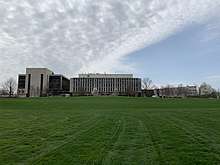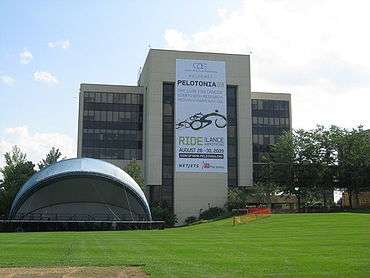Chemical Abstracts Service
Chemical Abstracts Service (CAS) is a division of the American Chemical Society. It is a source of chemical information. CAS is located in Columbus, Ohio, United States.
 CAS Headquarters Complex | |
| Formation | 1907 |
|---|---|
| Headquarters | Columbus, Ohio |
| Location |
|
Official language | English |
President | Manuel Guzman |
| Website | https://www.cas.org |
Print periodicals
| Discipline | Chemistry (index) |
|---|---|
| Language | English |
| Publication details | |
| History | 1907-2010 |
| Publisher | Chemical Abstracts Service (United States) |
| Frequency | Weekly |
| Standard abbreviations | |
| ISO 4 | Chem. Abstr. |
| Indexing | |
| CODEN | CHABA8 |
| ISSN | 0009-2258 |
| LCCN | 09004698 |
| OCLC no. | 1553947 |
| Links | |
Chemical Abstracts is a periodical index that provides numerous tools such as SciFinder as well as tagged keywords, summaries, indexes of disclosures, and structures of compounds in recently published scientific documents. Approximately 8,000 journals, technical reports, dissertations, conference proceedings, and new books, available in at least 50 different languages, are monitored yearly, as are patent specifications from 27 countries and two international organizations. Chemical Abstracts ceased print publication on January 1, 2010.[1]
Databases
The two principal databases that support the different products are CAplus and Registry.
CAplus
CAplus consists of bibliographic information and abstracts for all articles in chemical journals worldwide, and chemistry-related articles from all scientific journals, patents, and other scientific publications.
Registry
Registry contains information on more than 130 million organic and inorganic substances[2], and more than 64 million protein and nucleic acid sequences.[3][4] The sequence information comes from CAS and GenBank, produced by the National Institutes of Health. The chemical information is produced by CAS, and is prepared by the CAS Registry System, which identifies each compound with a specific CAS registry number, index name, and graphic representation of its chemical structure.
The assignment of chemical names is done according to the chemical nomenclature rules for CA index names, which is slightly different from the internationally standard IUPAC names, according to the rules of IUPAC.
Products
CAS databases are available via two principal database systems, STN, and SciFinder.
STN

STN (Scientific & Technical Information Network) International is operated jointly[5] by CAS and FIZ Karlsruhe, and is intended primarily for information professionals, using a command language interface. In addition to CAS databases, STN also provides access to many other databases, similar to Dialog.
SciFinder
SciFinder is a database of chemical and bibliographic information. Originally a client application, a web version was released in 2008.[6] It has a graphics interface, and can be searched for chemical structures and reactions as well as literature in chemistry and related disciplines.
The client version is for chemists in commercial organizations. Versions for both the Windows and MacOS operating systems exist. SciFinder Scholar[7] is for universities and other academic institutions.
CASSI
CASSI stands for Chemical Abstracts Service Source Index. Since 2009, this formerly print and CD-ROM compilation is available as a free online resource to look up and confirm publication information. The online CASSI Search Tool provides titles and abbreviations, CODEN, ISSN, publisher, and date of first issue (history) for a selected journal. Also included is its language of text and language of summaries.[8]
The range is from 1907 to the present, including both serial and non-serial scientific and technical publications. The database is updated quarterly.[8] Beyond CASSI lists abbreviated journal titles from early chemical literature and other historical reference sources.[9]
History
Chemical Abstracts (CA) began as a volunteer effort and developed from there. The use of volunteer abstractors was phased out in 1994. Chemical Abstracts has been associated with the American Chemical Society in one way or another since 1907.[10]
For many years, beginning in 1909, the offices of Chemical Abstracts were housed in various places on the campus of The Ohio State University in Columbus, Ohio.[11] In 1965, CAS moved to a new 50-acre (200,000 m2) site on the west bank of the Olentangy River, just north of The Ohio State campus. This campus became well known in the Columbus area and famous as the site of many Columbus Symphony Orchestra pop concerts. In 2009, the campus consisted of three buildings.
In 1907, William A. Noyes had enlarged the Review of American Chemical Research, an abstracting publication begun by Arthur Noyes in 1895 that was the forerunner of Chemical Abstracts. When it became evident that a separate publication containing these abstracts was needed, Noyes became the first editor of the new publication, Chemical Abstracts.
E. J. Crane became the first Director of Chemical Abstracts Service when it became an American Chemical Society division in 1956. Crane had been CA editor since 1915, and his dedication was a key factor in its long-term success.
Dale B. Baker became the CAS Director upon Crane's retirement in 1958. According to CAS, his visionary view of CAS' potential "led to expansion, modernization, and the forging of international alliances with other information organizations."[12] CAS was an early leader in the use of computer technology to organize and disseminate information.[13]
The CAS Chemical Registry System was introduced in 1965. CAS developed a unique registry number to identify chemical substances. Agencies such as the U.S. Environmental Protection Agency and local fire departments around the world now rely on these numbers for the definite identification of substances. According to the ACS, this is the largest chemical substance database in the world.
In 2007, the ACS designated its Chemical Abstracts Service subdivision an ACS National Historic Chemical Landmark in recognition of its significance as a comprehensive repository of research in chemistry and related sciences.[14]
See also
References
- "CAS Printed Products". CAS. Archived from the original on 2010-06-12. Retrieved 2009-12-02.
- "CAS Content at a Glance". www.cas.org. Retrieved 18 March 2018.
- 50 Millionth Unique Chemical Substance Recorded in CAS REGISTRY, Reuters.com
- "CAS Database Counter". cas.org.
- FIZ Karlsruhe. "STN International: Home". stn-international.com. Archived from the original on 2008-11-02. Retrieved 2008-07-10.
- "New SciFinder Available Via the Web Archived 2008-05-13 at the Wayback Machine". CAS. April 6, 2008.
- SciFinder Scholar Archived 2006-10-06 at the Wayback Machine, CAS
- "About the CAS Source Index (CASSI) Search Tool". Provided by Chemical Abstracts Service. American Chemical Society. December 2009. Retrieved 2016-08-26.
- Peters, Marion, Beyond CASSI (PDF), Chemical Abstracts Service, retrieved 2015-08-27
- American Chemistry Society. Chemical Landmarks, Chemical Abstracts. "ACS Online". Retrieved 2009-08-01.
- Chemical Abstracts Service. About CAS, CAS 100th Anniversary, CAS History: Milestones [Online]. http://www.cas.org/aboutcas/cas100/annivhistory.html Archived 2010-06-12 at the Wayback Machine. Accessed 8.1.2009
- Chemical Abstracts Service. About CAS, CAS 100th Anniversary, CAS History: Milestones, 1958 Dale Baker [Online]. http://www.cas.org/aboutcas/cas100/annivhistory.html Archived 2010-06-12 at the Wayback Machine. Accessed 8.1.2009
- David Flaxbart. Issues in Science and Technology Librarianship, Winter 2007. http://www.istl.org/07-winter/viewpoints.html. Accessed 8.01.2009
- Chemical Abstracts Service (CAS) Archived 2012-07-12 at Archive.today, American Chemical Society.